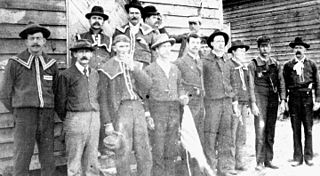White supremacy or white supremacism is the belief that white people are superior to those of other races and thus should dominate them. The belief favors the maintenance and defense of any power and privilege held by white people. White supremacy has roots in the now-discredited doctrine of scientific racism and was a key justification for European colonialism. It underlies a spectrum of contemporary movements including neo-Confederates, neo-Nazism and the so-called Christian Identity movement.

The Reconstruction era was a period in American history following the American Civil War (1861–1865); it lasted from 1865 to 1877 and marked a significant chapter in the history of civil rights in the United States. Reconstruction, as directed by Congress, abolished slavery and ended the remnants of Confederate secession in the Southern states. It proclaimed the newly freed slaves citizens with (ostensibly) the same civil rights as those of whites; these rights were nominally guaranteed by three new constitutional amendments: the 13th, 14th, and 15th, collectively known as the Reconstruction Amendments. Reconstruction also refers to the general attempt by Congress to transform the 11 former Confederate states and refers to the role of the Union states in that transformation.

"Lift Every Voice and Sing" is a hymn with lyrics by James Weldon Johnson (1871–1938) and set to music by his brother, J. Rosamond Johnson (1873–1954). Written from the context of African Americans in the late 19th century, the hymn is a prayer of thanksgiving as well as a prayer for faithfulness and freedom, with imagery which evokes the biblical Exodus from slavery to the freedom of the "promised land."

In the history of the United States, carpetbagger is a largely historical term used by Southerners to describe opportunistic Northerners who came to the Southern states after the American Civil War, who were perceived to be exploiting the local populace for their own financial, political, and/or social gain. The term broadly included both individuals who sought to promote Republican politics and individuals who saw business and political opportunities because of the chaotic state of the local economies following the war. In practice, the term carpetbagger was often applied to any Northerners who were present in the South during the Reconstruction Era (1865–1877). The term is closely associated with "scalawag", a similarly pejorative word used to describe native white Southerners who supported the Republican Party-led Reconstruction.

Colored is a racial descriptor historically used in the United States to refer to an African American. In many places, it may be considered a slur, though it has taken on a special meaning in Southern Africa.
The one-drop rule is a social and legal principle of racial classification that was prominent in the 20th century United States. It asserted that any person with even one ancestor of black ancestry is considered black. It is an example of hypodescent, the automatic assignment of children of a mixed union between different socioeconomic or ethnic groups to the group with the lower status, regardless of proportion of ancestry in different groups.

In United States history, the Redeemers were a political coalition in the Southern United States during the Reconstruction Era that followed the Civil War. Redeemers were the Southern wing of the Democratic Party. They sought to regain their political power and enforce white supremacy. Their policy of Redemption was intended to oust the Radical Republicans, a coalition of freedmen, "carpetbaggers", and "scalawags". They generally were led by the White yeomanry and they dominated Southern politics in most areas from the 1870s to 1910.
The Dunning School is a historiographical school of thought regarding the Reconstruction period of American history (1865–1877), supporting conservative elements against the Radical Republicans who introduced civil rights in the South. It is named for Columbia University professor William Archibald Dunning who taught many of its followers.

"New Negro" is a term popularized during the Harlem Renaissance implying a more outspoken advocacy of dignity and a refusal to submit quietly to the practices and laws of Jim Crow racial segregation. The term "New Negro" was made popular by Alain LeRoy Locke in his anthology The New Negro.

The Red Shirts or Redshirts of the Southern United States were white supremacist paramilitary terrorist groups that were active in the late 19th century in the last years of, and after the end of, the Reconstruction era of the United States. Red Shirt groups originated in Mississippi in 1875, when anti-Reconstruction private terror units adopted red shirts to make themselves more visible and threatening to Southern Republicans, both whites and freedmen. Similar groups in the Carolinas also adopted red shirts.

African-American newspapers are news publications in the United States serving African-American communities. Samuel Cornish and John Brown Russwurm started the first African-American periodical called Freedom's Journal in 1827. During the antebellum South, other African-American newspapers sprang forth, such as The North Star founded in 1847 by Frederick Douglass.

Religion of black Americans refers to the religious and spiritual practices of African Americans. Historians generally agree that the religious life of black Americans "forms the foundation of their community life". Before 1775 there was scattered evidence of organized religion among black people in the Thirteen Colonies. The Methodist and Baptist churches became much more active in the 1780s. Their growth was quite rapid for the next 150 years, until their membership included the majority of black Americans.

This is a selected bibliography of the main scholarly books and articles of Reconstruction, the period after the American Civil War, 1863–1877.

Jim Crow laws were state and local laws enforcing racial segregation in the Southern United States. Other areas of the United States were affected by formal and informal policies of segregation as well, but many states outside the South had adopted laws, beginning in the late 19th century, banning discrimination in public accommodations and voting. Southern laws were enacted in the late 19th and early 20th centuries by white Southern Democrat–dominated state legislatures to disenfranchise and remove political and economic gains made by African Americans during the Reconstruction period. Jim Crow laws were enforced until 1965.
The civil rights movement (1865–1896) aimed to eliminate racial discrimination against African Americans, improve their educational and employment opportunities, and establish their electoral power, just after the abolition of slavery in the United States. The period from 1865 to 1895 saw a tremendous change in the fortunes of the black community following the elimination of slavery in the South.

Gerald Horne is an American historian who currently holds the John J. and Rebecca Moores Chair of History and African American Studies at the University of Houston.
Black nationalism is a type of nationalism or pan-nationalism which espouses the belief that black people are a race and it seeks to develop and maintain a Black racial and national identity. Black nationalist activism revolves around the social, political, and economic empowerment of Black communities and people, especially to resist their assimilation into white culture and maintain a distinct Black identity.

Henry Louis "Skip" Gates Jr. is an American literary critic, professor, historian, filmmaker, and public intellectual who serves as the Alphonse Fletcher University Professor and Director of the Hutchins Center for African and African American Research at Harvard University. He is a Trustee of the Gilder Lehrman Institute of American History. He rediscovered the earliest African-American novels, long forgotten, and has published extensively on appreciating African-American literature as part of the Western canon.

African-American teachers educated African Americans and taught each other to read during slavery in the South. People who were enslaved ran small schools in secret, since teaching those enslaved to read was a crime. While, in the North, African Americans worked alongside Whites. Many privileged African Americans in the North wanted their children taught with White children, and were pro-integration. The Black middle class preferred segregation. During the post-Reconstruction era African Americans built their own schools so they didn't have White control. The Black middle class believed that it could provide quality education for their community. This resulted in the foundation of teaching as a profession for Blacks. Some Black families had multiple individuals who dedicated their lives to teaching. They felt that they could empower their communities. In the late 19th and early 20th centuries, Southern States passed Jim Crow laws to mandate racial segregation in all aspects of society, and prevent Blacks from voting. Racism made it difficult for Black professionals to work in other professions. In 1950, African American teachers made up about half of African-American professionals.
During the Reconstruction era, Alabama was put under U.S. military rule. A constitutional convention was held. Enslavement of African Americans ended and the federal Reconstruction Acts enshrined their basic civil and political rights. African Americans were elected to state and local offices and others were appointed to public offices. Public school systems were established including schools and colleges for African Americans.














